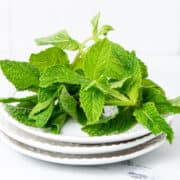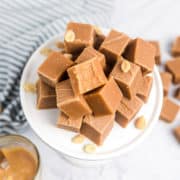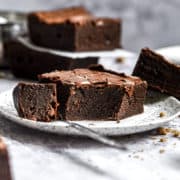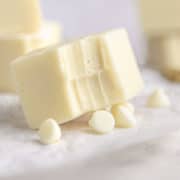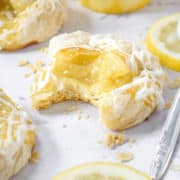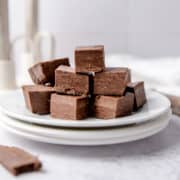Mint is a delicious herb and there are plenty of ways to use it. When you know how to store mint, you will be able to keep it fresh for longer and enjoy fresh mint leaves prepared in different ways.
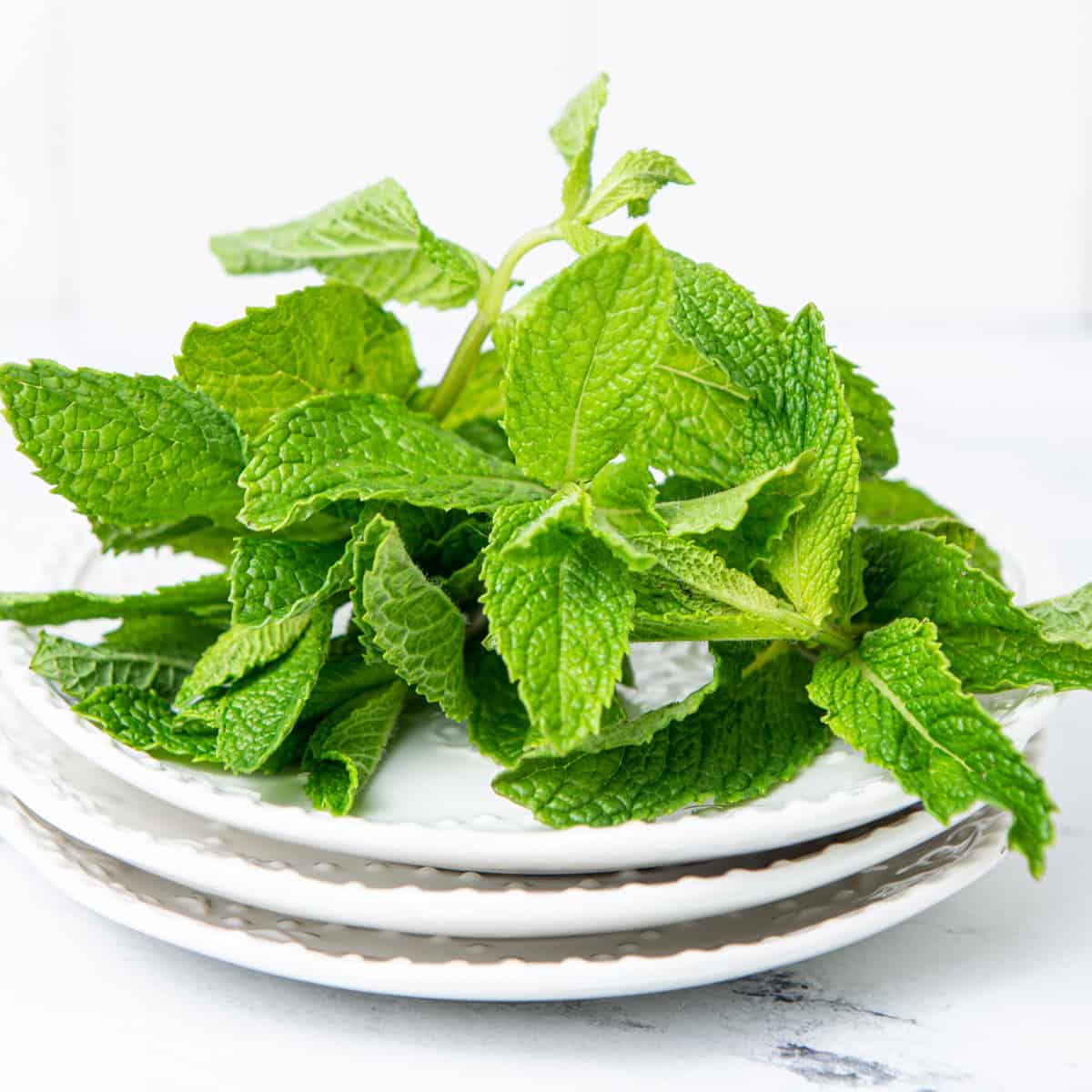
Jump to:
Fresh mint tea is always delicious and mint also features in recipes, both savory and sweet. It's popular in the Middle East and also in some Asian cuisines such as Vietnamese and Thai. It adds a fresh zing to salad dressings and sauces.
Use mint leaves as a beautiful garnish, adding a pop of color to desserts like cheesecake or tiramisu. It's also a nice addition to cocktails such as mojitos and is also used in essential oils because it smells so incredible.
I like to grow fresh mint but only in a container. If you don't use a container it spreads like crazy, so I really recommend you grow it in a container so it doesn't take over your whole backyard!
What is Mint?
Mint (Mentha) is an herb. There are about 12 varieties including peppermint and spearmint, as well as chocolate mint. All mint plants have a cooling sensation in the mouth, which is why this flavor is so popular in toothpaste, mouthwash, and so on.
You can get mint fresh or dried from the grocery store or farmer's market, although there is a lot of difference between them and fresh mint is many times tastier than the dried leaves.
It's a great source of Vitamin A as well as antioxidants. Iron, folate, and manganese are also found in fresh mint. Like with most other fresh herbs, mint should be added at the end of a recipe since cooking will greatly reduce its flavor.
So how long has mint been around? Well, it's hard to say, although there are records going back thousands of years. It's thought that the Romans introduced mint to England in the 1400s and that's when the first "toothpastes" were created, although they wouldn't have been anything like the modern equivalent.
It's likely the pilgrims were the first to introduce mint to the New World, and a 17th-century traveler called John Josselyn chronicled his trip to New England and talked about mint.
Before the days of refrigeration, spearmint used to be mashed and added to fresh milk because it preserved the milk well and stopped it from curdling.
Mint sauce or mint jelly, a popular condiment for lamb, is typically made with spearmint, which is milder than its cousin peppermint. You can use peppermint or garden mint though, if you prefer.
How to Buy Fresh Mint
When buying fresh herbs, you will often have a good sense of how healthy the herb is just by looking at it and mint is no exception to this rule. Good quality fresh mint can be purchased in bunches or potted.
I always look for bright green leaves without brown or black spots. The leaves on a bunch of mint should appear healthy and not be shriveled or wilted, although if only a couple of individual leaves are floppy that's fine. Also, it should give off that amazing mint aroma associated with a herb garden.

How to Store Mint
Because mint is so delicious and versatile, you'll want to know the best way to store it to keep it fresh and tasty, especially if you have a lot of mint. So let's take a closer look at how best to store it.
- One way to store fresh mint is to trim off the ends and keep it in a glass of water on the countertop, changing the water when it gets cloudy. It should last about a week if kept out of direct sunlight.
- Another way is to keep it in the refrigerator. Again, trim the ends and keep it in a glass of water or glass jar, but loosely cover the mint with a plastic bag. You don't have to change the water but it's best to use the mint within 3 weeks. It might droop a little, but it will still taste fresh.
- A third storage method is to wrap the mint in a damp paper towel and then put that into a Ziploc bag or airtight container and keep it in a cool, dry place, ideally the crisper drawer of the fridge. It takes up little space when stored this way.
- If you bought a mint plant in a pot, keep the soil moist but not wet. Keep it at room temperature, on a sunny windowsill, or even outside if it's not too cold.
You can also freeze mint. Put it in an ice cube tray and add cold water. These mint ice cubes are great for drinks and cocktails but not much else. They will add a nice flavor to lemonade or mint juleps, but if you thaw them you'll just have some soggy mint leaves, so for recipes, it's best to use fresh. Mint ice cubes will keep for 6 months.
If you prefer to freeze them without the excess water in the ice cube method, the right way is to freeze your mint in a single layer and then transfer it into a freezer bag or an airtight container. Again, it will keep for about 6 months when frozen in this way.
How to Tell if Mint is Spoiled
Spoiled mint will be yellow or brown and the leaves will be floppy and wilted. There might be slime or mold on the mint, or it might smell bad. If you see any of those things, it's best to throw the mint out.
Common Questions
There are plenty of ways to use fresh mint, including mint sauce which is delicious with lamb. Chop the fresh leaves finely and mix with vinegar and sugar. You can infuse mint in hot water to make mint tea. Make cocktails like mojitos or add it to salads. You can use it in marinades, pairing it with lemon juice and olive oil, for example, which is a great way to add a fresh flavor.
I also like to use it to make pesto in the food processor in place of basil for a new twist on the classic recipe. I'm sure you will find plenty more easy ways to use mint, either the whole leaves or the stem too. And don't forget a few mint sprigs add a pop of color to desserts, even if they're just used for decoration.
Fresh mint, spearmint, and peppermint are all in the same family of plants but they smell and taste slightly different. Fresh mint is a little tangy with a sweet taste developing into a cool, refreshing aftertaste. This is the type of mint you'd use to make cocktails, tea, dessert, and so on. Peppermint has a stronger flavor and is used to make toothpaste, gum, and candy. The plant is darker in color and the leaves are a little fuzzy.
And then there is spearmint which is sweeter and milder than peppermint and often features in savory recipes like stews, sauces, and soups. It's paler in color and smoother to the touch than peppermint. So although they're all similar, each type of mint is slightly different. They all have a similar shelf life.
Basil, which is in the same plant family as mint, pairs well, as does the citrus-like flavor of cilantro. Cardamon has a floral, warm taste which is good with mint in drinks and desserts, and ginger is another good one because of its warming, spicy flavor. If you're making mint pesto, you will find that garlic really brings out the mint flavor. Fennel's licorice flavor also goes well with fresh mint.
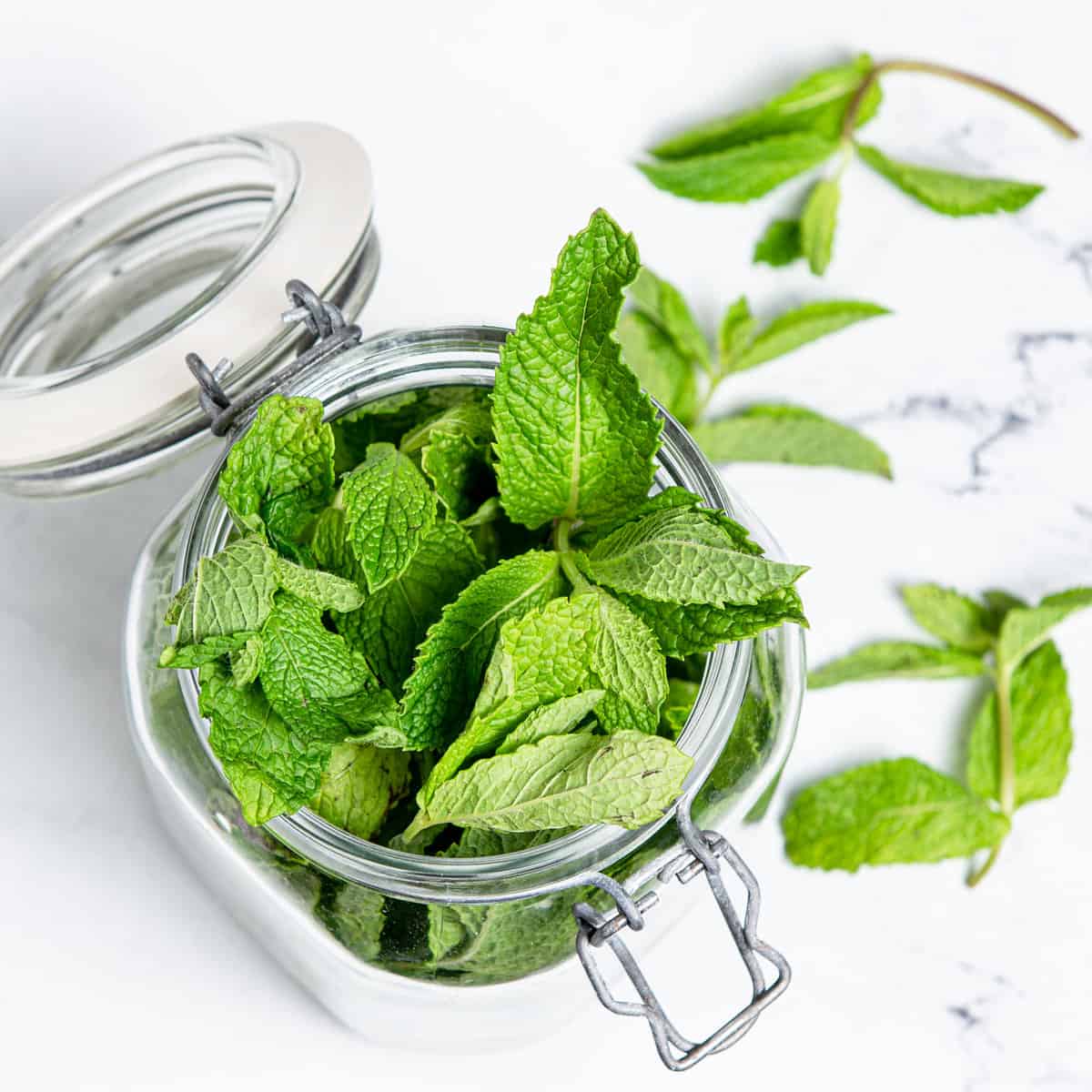
Interesting Facts
- Although there are more than 30 types of mint, the most commonly used ones are garden mint, peppermint, and spearmint.
- Mint was a hospitality symbol in ancient times and was offered to guests.
- The essential oil of peppermint is used in mouthwash and toothpaste for its cooling and refreshing flavor as well as antiseptic properties.
Now you know how to store mint to keep it fresh and delicious. This versatile, aromatic herb can be used in all kinds of dishes, both sweet and savory, as well as in various beverages or simply used as a garnish.
